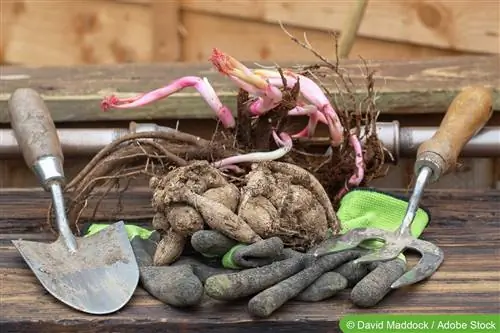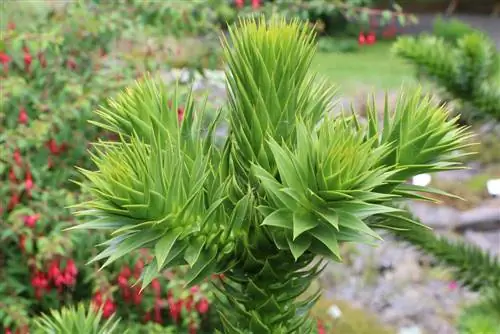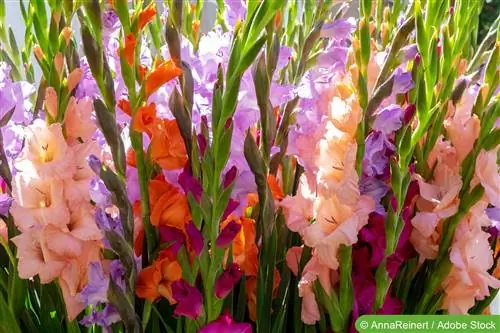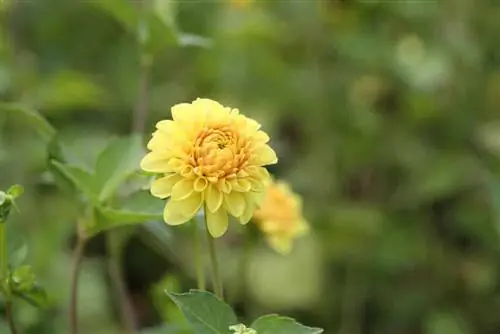- Author admin [email protected].
- Public 2023-12-17 03:39.
- Last modified 2025-01-24 12:45.
Dahlias and gladioli are among the most popular bulb and tuber plants. As grateful, permanent bloomers, they give you an incomparable display of flowers from June to October. Dahlias and gladioli look best in flower beds or as borders. But they are also wonderfully suitable as cut flowers.
Dahlias (Dahlia) originally come from Mexico. Many species are now native to us. Dahlias can grow up to 140 cm high. They bloom from July to October and their flowers can reach a diameter of up to 15 cm.
The gladioli (Gladiolus), which come from South Africa, are now represented in Central Europe.
Depending on the variety, the gladioli can reach a height of up to 150 cm. Its flowering period extends from June to October, the long inflorescences appear in spike-like form.
Dahlias and gladioli are robust and undemanding plants. However, your tubers should be overwintered frost-free.
This is how your dahlias and gladioli get through the winter well
The tubers of dahlias and gladioli are not hardy. However, under certain conditions they can be overwintered very easily. Remove the tubers from the ground before the first frost and store them in a dark and frost-free place in the house. So that the tubers can store water and mature better, the plants should no longer be watered from October onwards. Mid-November is the ideal time to take the tubers out of the ground. Cut away the dead foliage close to the ground and use a digging fork to dig it up. Carefully remove the tubers from the garden soil. To make it easier for the soil to loosen, it is best to let the tubers dry in a warm place for a few days. Remove the dry onion skin from the gladioli.
To prevent rot, also let them dry for a few days. However, be sure to protect the gladiolus bulbs from drying out. The smaller breeding tubers are separated and can also be overwintered. Keep only he althy bulbs and tubers. Rotting and damaged specimens can transmit rot and diseases to the he althy tubers and are best composted straight away. Wooden boxes lined with newspaper are suitable as good winter quarters for dahlia tubers.
Bedge the he althy tubers in a dry peat-sand mixture. To save space, you can do this in layers. However, make sure that the individual tubers do not touch each other. The temperature should be around 5° C; in warmer temperatures the dahlia tubers will sprout early. If humidity is high, store the bulb and tubers in dry sawdust. If the humidity is low, the tubers can dry out and shrink. In this case, store about 5 pieces in a plastic bag with a few air holes.
It is also possible to overwinter the individual bulbs and tubers wrapped in newspaper. While the tubers of dahlias and gladioli remain in their winter quarters, they do not need any water or fertilizer. But check them regularly for rot and infestation and remove diseased specimens. If you have a lot of different bulbs and tubers, it will be helpful for planting planning the following year if you label the individual pieces.
The ideal location is crucial for strong growth
Dahlias and gladioli thrive best in a sheltered spot in full sun or partial shade. Place the tubers in good, humus-rich garden soil. The soil should be nutrient-rich and permeable, as waterlogging should be avoided at all costs due to the risk of rot. Give tall growing varieties support by protecting them from twisting with suitable plant supports.
The right planting: the perfect start to the new flowering season
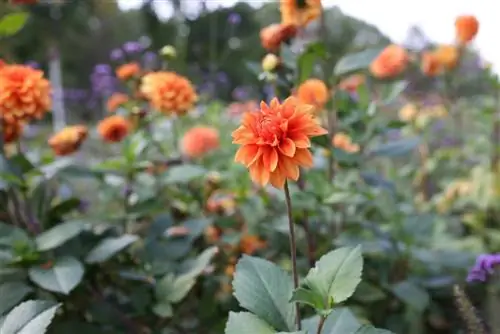
The ideal time to plant dahlia tubers is the beginning of May. Young plants grown indoors are sensitive to frost and are only allowed outside from mid-May, after the Ice Saints. Plant at a depth of 5 to 10 cm, with the root neck pointing upwards. The distance between the individual tubers should be at least 30 cm. For tall varieties, choose a planting distance of around 100 cm. Cover the tubers with a 5 cm layer of soil. The gladioli can go outside from mid-April. Plant the bulb with the flat side down at a depth of 10 to 15 cm and also ensure there is plenty of space between the individual bulbs. As soon as the first shoots appear, the dahlias and gladioli can be watered. Do not water too early, otherwise there is a risk of rot!
Careful care strengthens the plants and increases flowering
Regular watering and fertilizing promote growth and flowering. However, be sure to avoid too much water and waterlogging, as this can lead to rot. If you continually remove dead flowers and seeds, the plants will thank you with long-lasting flowering. Regular cleaning strengthens the plants and helps prevent possible fungal diseases. The last fertilization takes place in August, because from this point on the tubers can still mature well, gather enough strength and thus prepare for the upcoming wintering.
Sometimes pests and diseases appear
Dahlias and gladioli are robust plants. But pests or diseases can also occur here. The young shoots of the dahlias occasionally fall victim to snail damage. Natural snail control products provide quick relief. The gladiolus may be susceptible to gray mold or leaf spot. Various treatment products are available in specialist stores.
Dahlias and gladioli as undemanding permanent bloomers
Dahlias and gladioli are among the most popular bulb and tuber plants. These grateful perennial bloomers are robust and easy to care for. They need good, well-drained garden soil and love a sheltered place in the sun. If you overwinter the tubers carefully, you will be rewarded with a magnificent variety of flowers year after year.
Tips for overwintering dahlias
Dahlia tubers are dug up before the first night frosts set in and the soil and remaining leaf residue are removed. To overwinter they need a place where it is airy and ideally around 5°C. To prevent the tubers from rotting, it is best to place them on a wire rack and turn them occasionally during the winter. Rotten parts of the tubers can also be removed straight away.
Overwintering gladioli
Gladiolus tubers are also dug up in autumn; the best time to do this is when they have already grown their leaves. Then the soil and the rest of the leaves are removed from them and stored in an airy place on a wire rack, in a cardboard box or in a wooden box. The temperature in the winter quarters of gladioli can be slightly higher than that of dahlias. However, it should not be more than 15° C.
Some gladioli bloom in September or even later. Then it is usually not worth overwintering the tubers because the plant does not have enough time to store the necessary nutrients in its tuber until the onset of winter. The same problem also exists when many flowers have been cut to use in a vase. Then the necessary foliage for photosynthesis was missing and it is advisable to buy new tubers for next year in order to have beautiful flowers again.
Replanting dahlias and gladioli
Both flowers can be replanted in the garden in April. Night frosts can still occur, but the risk of the tubers being damaged is relatively low. This way, even after flowering, they still have enough time to collect enough nutrients for the next winter.
- Dahlias and gladioli need a sunny place to produce beautiful flowers. A hole about ten centimeters deep is dug for each tuber, the tuber is placed in it and covered with soil.
- Gladiolus should not be planted in the same place as last year because the flowers will not be as beautiful there.
- When planting, make sure that the tubers are not placed upside down. The old shoots should point upwards again; with gladioli the flat side should be facing downwards.
- At the same time as the tuber is planted, the stick should also be inserted into the ground, which will later serve as a support for the flowers. This way the tuber will not be damaged later.

